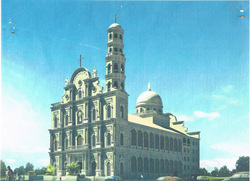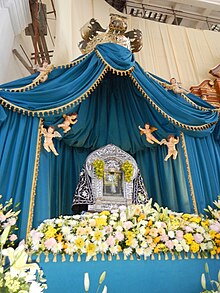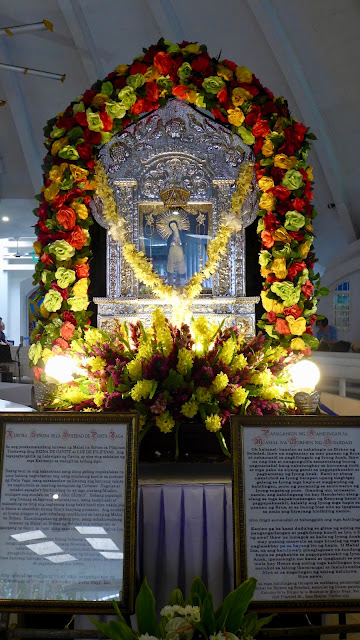Back in the days when the Philippines was under Spanish rule, an event took place in the province of Cavite, outside of Manila. There is a narrative which involves a soldier from the Spanish Guardia Civil who was on duty at the little garrison at the port in Cavite, at the Vaga Gate.
It was a stormy night when the Spaniard noticed a bright light arising from Cañacao Bay. Startled, he immediately concluded that it was coming from a pirate ship that was coming to attack the port. But soon, the light came towards him. Alarmed, he commanded it to stop. As it continued to come towards him, he asked who it was:
"¿Quién vive?" (Who is there?)
With a sweet voice, the answer came:
"Sodadito, ¿for qué el alto me das en niche tan friars? Dame paso. ¿No canoces a Maria? (Little soldier, why do you halt me in this night so cold" Give me passage. Do you not know Mary?")
"Perdoname, Virgen Maria, Reina de mi Devoción. Pues, solo soy un soldado que cumplo mi obligación." (Forgive me, Virgin Mary, Queen of my Devotion, I am but a soldier who complies with my duty.)
The next day, at the break of dawn, some fishermen and workers at the Cavity Royal Arsenal who passed through the Vaga Gate, discovered a framed image of the Virgin Mary on the beach, near the apparition site the night before. They picked it up and brought it to the parish priest, who temporarily enshrined it in the parish church. In time, the Ermita de Porta Vaga (Chapel of Vaga Gate) was built right along the walls of the port. The image of Our Lady stayed here for three centuries and this became known as the shrine of Our Lady of Solitude of Porta Vaga.

The Ermita de Porta Vaga (Chapel of Porta Vaga), along the walls of the Cavite Port - the original shrine of Our Lady of Solitude of Porta Vaga, c. 1899.
In 1929, a new parish priest - Fr. Pedro Lerena - from Logroño, Spain, arrived and was assigned at the Cavite Port and became the restorer of the Ermita. Through the years, he worked towards the beatification of Our Lady of Porta Vaga and the beautification of the chapel.
Sadly, during WWII, the Japanese Imperial Army had occupied the Philippines and disrupted life for the Filipinos. Fr. Larena found the image of Our Lady of Porta Vaga which had thrown in a junkyard. Upon its retrieval, the image was brought to the Arzobispado (Archbishop's Palace) in Intramuros, just before it was left at the Philippine National Bank's vault for safekeeping.
After the liberation of the Philippines from Japanese occupation in 1945, the image was brought back to Cavite, at the San Roque Church. By this time, the Ermita had been bombarded and destroyed in the course of WWII. Fr. Lerena remained as the guardian of the icon util his death in 1972
The icon is crowned and ensconced in a silver frame, and clothed in a black and silver manto.
It came to be known as Nuestra Señora de la Soledad de Porta Vaga (Our Lady of Solitude of Porta Vaga), or commonly referred to as Our Lady of Porta Vaga. She is the Patroness of the province of Cavite. The devotion to Our Lady by the Caveiteños is one of the oldest in the Philippines.
Several other titles have been given to her: Queen of Cavite (Reina de Cavite); Exalted Patroness of the Celestial Guardian and Protectress of the Province of Cavite and its Port (La Excelsa Patrona y la Celestial Guardiana y Protectora de la Provincia de Cavite y su Puerto). She also was the "Patroness of the Galleons," as the icon was used to bless the galleons during the trading days between Cavite and Acapulco, Mexico. Many miracles had been attributed to Our Lady, thus, she also was known as "The Virgin of Thousand Miracles."
It was on November 17, 1978, when the icon of Nuestra Señora de Soledad de la Porta Vaga - thanks to the efforts of Msgr, Baraquel Monica - former parish priest of San Roque, and Bishop Felix Pérez of the Diocese of Imus - was canonically crowned by the Apostolic Nuncio to the Philippines - Bruno Torpigliani, D.D., at a high mass that was held at the Binondo Church. This was the first Marian image crowned under the pontificate of St. John Paul II.
The icon that was much venerated was stolen on March 16, 1984. After several months, it was recovered stripped of ornamentation, on the Feast of the Assumption on August 15, 1984. To the credit of her devotees, the icon was restored and re-enshrined in the altar in a joyful celebration.
There are several accounts of miracles attributed to Our Lady of Port Vaga. Firstly, her miraculous arrival on the port in Cavite. Then, while she was enshrined at Ermita de Porta Vaga, there was a typhoon in 1856. A fire that was caused by lightning that struck the wooden altar leveled the chapel down to the ground. Among the ashes, was found undamaged, was Our Lady of Porta Vaga.
Counted among her devotees were sailors. On one stormy night, on June 30, 1857, there was a Spanish Frigate - the Lucero - based in Cavite, that ran aground along the coast of Albay. With the low tide and the absence of a strong breeze in the following days, the frigate remained stuck for more than three weeks, at which time, the provisions were running low. One of the crewmen took our Our Lady's picture and invited his fellow crewmen to pray for her intercession.
On a full moon, one evening, la Virgen de la Soledad appeared before them. As the crewmen got down on their knees, the tide began to rise and a breeze came, enabling the frigate to float from its trapped position, enabling it to return to the port in Cavite. Back on land, the sailors went to the Ermita to give their thanks.
In 1882, a cholera epidemic had taken its toll on the Caviteño population. The epidemic was brought under control by mid-October after gun powder was burned on the streets, under the order of the Spanish military governor of Cavite - Don Juan Salcedo y Mantilla delos Rios. However, the governor himself got afflicted.
As the governor was about to take his nap, one afternoon, he heard a persistent knocking on the door. Previously, he had given order to not be disturbed. As he opened the door, and old woman dressed in black asked him to celebrated the forthcoming fiesta with much flare. Salcedo hurriedly agreed.
Right after the old lady left, the governor called his soldiers to reprimand them for letting the lady through. When the guards replied that they did not see any lady, Salcedo quickly realized that his visitor must have been the Blessed Mother. And instantly, he was cured.
m
Through the years, more miracles of physical healings, families reunited, or problems solved - through the intercession of Ntra. Señora de Soledad de la Porta Vaga - have been reported.
*********
A replica of Our Lady of Solitude of Porta Vaga is on a holy tour
... and she stopped-over to be venerated at the Sto. Niño de Paz Chapel, located at Greenbelt Park, Ayala Center, Makati City, from August 27 to September 3, 2017.
The story of the miraculous apparition of the icon in the vernacular - Tagalog
The prayer to Our Lady of Porta Vaga in Tagalog
A closer look at the icon, shows the Virgin Mary dressed in Black with white, mourning, kneeling as she contemplates the various objects used by her Son during the Passion - the crown of thorns and the nails. The icon is a painting on canvass - embellished with gold and silver, and precious gems that were given by devotees in order to fulfill a vow, beautifully, framed in carved wood.
An ornately embroidered velvet cape drapes behind the painting.
The icon is considered as the oldest existing painting of the Virgin Mary in the Philippines. On the reverse side, there is an inscription that reads -
" A doze de Abril 1692 años Juan Oliba puso esta Stma, Ymagen Haqui." (on April 12, 1692, Juan Oliba placed this most holy image here.)
The original icon is unde the guardianship of the Confradia de la Virgen de la Soledad de la Porta Vaga. The confraternity was founded on November 17, 1998. They continue to bring bring her to us, to spread the devotion to Mary.

The San Roque Church now

Original Bejeweld Painting of Our Lady of Solitude of Porta Vaga
|
During the First Saturday Devotion to the Immaculate Heart of Mary, the original icon in Cavite is exposed for veneration. It starts with the recitation of the rosary and the novena prayer at 11:00 in the morning, and a Misa de la Reina follows. The confraternity meets, thereafter, to discuss plans to continue spreading the devotion to Our lady of Porta Vaga. Her feast day is celebrated on the 2nd and 3rd Sundays of November.
Thanks to her visit at the Greenbelt Chapel, I got the chance to meet her. I am renewed in believing that Our Lady really cares about us as she continues to appear in other parts of the world, to this day.







